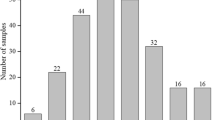Abstract
Three plastic-house experiments were conducted to compare the tolerance of European with West Asian and North African (WANA) winter barleys to boron (B) toxicity. Experiment I screened 24 winter barley entries with diverse origins. Experiment III tested 420 random accessions from seven European and seven WANA countries. Plants were screened in a soil mixed with boric acid (50 mg B/kg) and foliar B-toxicity symptom scores were recorded. Lower scores indicated higher B-toxicity tolerance. In Experiment II, five lines/varieties from each of the European and WANA groups were grown in pots with two soil B levels (0 and 25 mg B/kg). The West Asian landrace barleys had a lower mean B-toxicity symptom score than the European ones. The Syrian landrace variety normally grown in drier areas had a lower score than the Syrian landrace variety grown in wetter areas. Dry weights of the European and WANA groups were not different without adding B, but dry weight under 25 mg B/kg was lower for the European group than the WANA group. European accessions had a higher mean B-toxicity symptom score than the WANA accessions. Iranian and Afghan accessions had the lowest mean scores among countries. These results support the hypothesis that European winter barley varieties and accessions are less tolerant to B toxicity than those WANA accessions and varieties developed from local landraces. The lower B-toxicity tolerance could be a factor adversely affecting the performance of European winter barley varieties in the highlands of WANA.
Similar content being viewed by others
References
Bagheri, A., J.G. Paull & A.J. Rathjen, 1994. The response of Pisum sativum L. germplasm to high concentrations of soil boron. Euphytica 75: 9–17.
Bingham, F.T., 1982. Boron. In: A.L. Page (Ed.), Methods of Soil Analysis, Part 2, 2nd Edition, pp. 431–447. Am Soc of Agronomy & Soil Sci Soc of Am, Madison.
Cartwright, B., B.A. Zarcinas & A.H. Mayfield, 1984. Toxic concentrations of boron in a red-brown earth at Gladstone, South Australia. Aust J Soil Res 22: 321–332.
Gupta, U.C., 1979. Boron nutrition of crops. Adv Agron 31: 273–307.
Harmsen, K. & P.L.G. Vlek, 1985. The chemistry of micronutrients in soil. In: P.L.G. Vlek (Ed.), Micronutrients in Tropical Food Crop Production, pp. 1–42. Martinus Nijhoff/Dr. W. Junk Publishers, Dordrecht.
ICARDA, 1998. Germplasm Program - Cereals: Annual Report for 1996. The International Center for Agricultural Research in the Dry Areas, Aleppo.
ICARDA, 1999. Germplasm Program - Legumes: Annual Report for 1997. The International Center for Agricultural Research in the Dry Areas, Aleppo.
Moody, D.B., A.J. Rathjen, B. Cartwright, J.G. Paull & J. Lewis, 1988. Genetic diversity and geographical distribution of tolerance to high levels of soil boron. In: T.E. Miller & RM.D. Koebner (Eds.), Proc 7th Int Wheat Genetics Symp. Vol 2, pp. 859–865. Inst Plant Sci Res, Cambridge, U.K.
Nable, R.O., 1988. Resistance to boron toxicity among several barley and wheat cultivars: a preliminary examination of the resistance mechanism. Plant and Soil 112: 45–52.
Nable, R.O., 1992. Mechanism of tolerance to boron toxicity in plants. In: C.E. Mann & B. Rerkasem (Eds.), Boron Deficiency in Wheat, pp. 98–109. CIMMYT, Mexico, D.F.
Nable, R.O., B. Cartwright & R.C.M. Lance, 1989. Genotypic differences in boron accumulation in barley: relative susceptibilities to boron deficiency and toxicity. In: N. El Bassam et al. (Eds.), Genetic Aspects of Plant Mineral Nutrition, pp. 243–251. Kluwer, The Netherlands.
Paull, J.G., B. Cartwright & A.J. Rathjen, 1988. Response of wheat and barley genotypes to toxic concentrations of soil boron. Euphytica 39: 137–144.
Ralph, W., 1986. Boron toxicity in southern cereals. Rural Res 130: 25–27.
Ryan, J., S. Masri, S. Garabet, J. Diekmann & H. Babib, 1997. Soils of ICARDA's Agricultural Experimental Stations and Sites: Climate, Classification, Physical and Chemical Properties, and Land Use. International Center for Agricultural Research in the Dry Areas, Aleppo.
Ryan, J., M. Singh & S.K. Yau, 1998. Excess boron in Syrian soils and implications for plant growth. Soil & Tillage Research 45: 407–417.
Shorrocks, V.M., 1997. The occurrence and correction of boron deficiency. Plant and Soil 193: 121–148.
Sillanpaa, M., 1982. Micronutrients and the Nutrient Status of Soils: A Global Study. FAO, Rome.
Tahir, M. & A. Ottekin, 1997. Winter and facultative barley germplasm improvement for continental Mediterranean environments. Rachis 16: 1–8.
Tahir, M. & H. Pashayani, 1988. Characteristics of cereal germplasm suitable for high-altitude areas of West Asia and North Africa. In: J.P. Srivastava, M.C. Saxena, S. Varma & M. Tahir (Eds.),Winter Cereals and Food Legumes in Mountainous Areas, pp. 273–285. ICARDA, Aleppo.
Yau, S.K., 2000. Soil-boron affects straw quality and other agronomic traits in two cultivars of barley. Commun Soil Sci Plant Anal 31: 591–604.
Yau, S.K. & W. Erskine, 2000. Diversity of boron-toxicity tolerance in lentil. Genetic Res & Crop Evol 47: 55–61.
Yau, S.K. & M.C. Saxena, 1997. Variation in growth, development, and yield of durum wheat in response to high soil boron. I. Average effects. Aust J Agric Res 48: 945–949.
Yau, S.K. & M. Tahir, 1996. Variation in boron-toxicity tolerance causes G × E interaction in yield. In: Abstracts of Poster Sessions of 2nd Int Crop Sci Congress, p. 138. National Academy of Agric Sci and Indian Council of Agric Res, New Delhi.
Yau, S.K., J. Hamblin & J. Ryan, 1994. Phenotypic variation in boron toxicity tolerance in barley, durum and bread wheat. Rachis 13: 20–25.
Author information
Authors and Affiliations
Rights and permissions
About this article
Cite this article
Yau, SK. Comparison of European with West Asian and North African winter barleys in tolerance to boron toxicity. Euphytica 123, 307–314 (2002). https://doi.org/10.1023/A:1015047523382
Issue Date:
DOI: https://doi.org/10.1023/A:1015047523382




